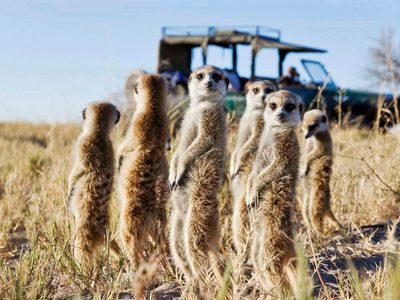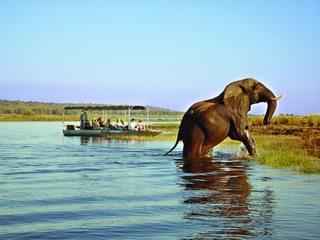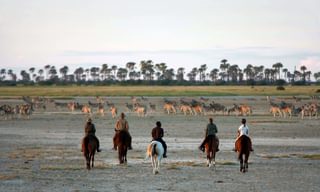Speak To Our Botswana Experts Today
Plan your perfect Botswana safari

Alistair
Travel Expert

Can't decide where to go? Why not peruse some of our most popular destinations for inspiration then give us a call!

A diverse land brimming with superb safaris, pristine sandy beaches, towering snow-capped peaks and tropical underwater worlds is just waiting to welcome you

Australia offers vibrant cities, diverse landscapes, and iconic wonders like the Great Barrier Reef. New Zealand adds dramatic scenery, Maori culture, and relaxed charm. Together, they promise nature, adventure, culture, and warm hospitality.

If you're dreaming of an island getaway, look no further than the Caribbean with its gorgeous soft sand beaches and lively, diverse cultures.

Head to the amazing destination that is Central America, full of the knowledge of ancient civilizations, incredible mountains, and beautiful beaches.

Discover vibrant cultures, pristine beaches, and tantalizing flavours in the captivating travel haven that is East and Southeast Asia

Embark on a journey through the vibrant tapestry of India, Sri Lanka, and Bhutan—where ancient temples, lush tea plantations, and soaring Himalayan peaks promise unforgettable moments at every turn.

Picture yourself basking on sun-kissed beaches, sipping tropical cocktails beneath swaying palms —where crystal-clear lagoons and luxurious resorts cater to your every desire.

Experience world-class hospitality, mouthwatering cuisines, and the region’s deep-rooted cultural traditions for an unforgettable Middle East adventure.

Venture to the ends of the Earth and behold the icy majesty of polar landscapes. Discover pristine solitude, exhilarating expeditions, and breathtaking views that promise a memorable encounter with nature at its most dramatic

Journey into the heart of South America, where the rhythmic pulse of its vibrant cities meets the majesty of the Amazon rainforest and the timeless wonder of ancient civilizations.

The South Pacific is a paradise of turquoise waters, white-sand beaches, and vibrant island cultures. From adventure and natural beauty to pure relaxation, each island offers its own unique charm and welcome.

From the soaring plains of the Southwestern USA to the stunning landscapes of the expanses of Canada, visit some of the most impressive scenery in the world

If you are looking for a trip to knock iconic locations off your bucket list, check out our buck list recommendations

From the graceful stride of giraffes at sunrise to the echoing roars of lions beneath starlit skies, each of our safaris promises an unforgettable dance with nature.


Our family holidays are a perfect opportunity to create lasting memories, whether exploring new destinations or simply enjoying quality time together. From adventure-filled escapes to relaxing beach retreats, they offer a chance to reconnect and unwind away from daily routines.

Our luxury holidays offer the finest experiences, from exclusive resorts and private villas to tailor-made adventures with impeccable service.

For those seeking adventure beyond the usual tourist trails, our off-the-beaten-track trips take you to some of the world’s most remote and untouched destinations, where authentic cultural encounters and breathtaking landscapes await. Let us craft your unique journeys that few travellers ever experience.

For the ultimate beach escape, we offer luxury holidays to some of the world’s most stunning coastal destinations, from the white-sand shores of Antigua to the turquoise waters of Zanzibar.

For those who crave excitement and exploration, our adventure holidays take you to some of the world’s most thrilling destinations, whether trekking through Patagonia, summiting Mount Kenya, or kayaking past icebergs in Antarctica.

Interested in something a bit more focused? How about a horse-riding holiday through Argentina? Or a photography safari? Look through our Special Interest holiday selection for inspiration

Our wildlife holidays invite you to step into unique ecosystems and experience amazing animal encounters. Whether spotting majestic tigers in the jungles of India or marvelling at polar bears in the Arctic, each trip promises awe-inspiring moments steeped in the magic of nature.

Our small group tours offer the perfect balance of expert-guided exploration and personal experience, taking you to incredible destinations with like-minded travellers. Whether it's a wildlife safari in Botswana, a cultural journey through Vietnam, or a chef-led expedition through India, our carefully curated itineraries ensure an intimate, enriching, and hassle-free experience.

Sustainability travel is at the core of what we do and a guiding principle in every choice we make as a business. Let us help you make sustainable travel choices

Read about what we do to make a difference

One of the most important parts of our commitment to responsible travel is protecting our clients, and it is a part that we take extremely seriously.

Not sure what's best for which time of year? Check out our expert-written guides

Looking for some expertise on your destination? Have a look through our selection of guides and articles written by our destination experts

Looking for more inspiration? Read from our range of hundreds of articles from our travel specialists, local guides, and personal travel tales.

Our mission is to make every holiday special. We will do this whilst specifically aiming to minimise the environmental impact of our activity and maximise our opportunity to influence others to do the same.

When it comes to African safari destinations, Botswana is a little bit special. As well as ticking all the boxes for abundant wildlife and of course the Big Five, it’s the variety of landscapes that makes the country stand out.
From river delta to arid desert and everything in between, Botswana is a relatively untouched wilderness where adventurous travellers can enjoy safaris with the feeling of exclusivity.
So if you are planning a Botswana safari holiday, here are our top destinations to visit.
Most first-time visitors to Botswana make a bee-line for the Okavango Delta. And rightly so.
Labelled by many as one of the most beautiful places in Africa, the emerald delta covers 15,000 km² during the high-water months, transforming the landscape into labyrinthine channels, lagoons of lilies and islands of lush greenery.
It’s a haven for wildlife and all the usual suspects can be found here, including elephants, buffalo and giraffe, closely followed of course by lions, hyenas and even rare wild dogs. It’s also the perfect place to spot the semi-aquatic red lechwe antelope and if you’re into birds, you won’t be disappointed.
Whilst game drives and bush walks are possible here, the main event is safari by water. There’s nothing quite like gliding serenely through the reeds in search of crocodiles and kingfishers whilst relaxing in a traditional mokoro (dugout canoe) under the expert steerage of a local guide.
For more information, read our complete guide to safaris in the Okavango Delta.

Chobe is the place to go for your elephant fix, especially if you’re visiting during the dry season when they congregate down by the river in their thousands.
The park is understandably the most popular game reserve in Botswana, and is accessible by car which makes it a little less expensive than some of the other more remote reserves. Always a bonus.
Chobe is the second largest park in Botswana, with landscapes ranging from floodplains and marshland, to savannah and woodland. One of Chobe’s specialities is sunset game viewing on a river cruise. An excellent vantage point from which to watch the animals as they come down to drink in the fading light and always popular on a Botswana honeymoon.
When it comes to wildlife Chobe pretty much has it all. As well as its enormous elephant and buffalo populations, the area is teeming with life from all along the food chain, including giraffe, kudu, tsessebe, lions, cheetah and if you’re lucky, leopards. Wild dogs can sometimes be seen here too.

If you’re searching for untouched wilderness, then you could do worse than visit the Moremi Wildlife Reserve in the north-east of Botswana. The reserve has an incredible variety of ecosystems, from lagoons and floodplains to grasslands and even acacia forests.
Known as one of Africa’s more diverse wildlife areas, Moremi is a network of waterways full of lily pads, hippos and a spectacular range of colourful birdlife – there are over 500 species. Herbivore herds are common too, and elephants often come down to the water to drink.
Perhaps even more exciting are the black and white rhino that roam the area, as well as the excellent predator sightings that come with such abundant prey.
Moremi is a fenced reserve which means game viewing is spectacular throughout the year. Bush walks, game drives and canoe safaris are the order of the day here, and it’s the perfect place to tick off the all-important Big Five sightings.
The semi-arid Kalahari Desert is a remote terracotta wilderness with sprawling plains extending nearly a million km² across southern Africa. It’s one of the world’s least inhabited areas (most people here are San Bushmen) so it’s a great place to go if you like getting away from it all.
The Central Kalahari Game Reserve experiences some of the most dramatic landscape transformations ever seen in the world, all thanks to the rains. Temporary lakes form in the desert, followed by marsh before the land becomes dry once again. With the water come the animals, the most notable being the legendary black-maned lions who like to check out the enormous herds of impala, zebra and oryx. Cheetahs sometimes join in the fun too.

For something a bit different, head over to the otherworldly landscapes of the Makgadikgadi Pans where salt glistens in the sun as far as the eye can see. Millions of years ago a lake the size of Switzerland covered this area of the Kalahari, and today the salt pans are the largest in the world.
There’s still a real sense of ancient history all around, with ancient baobab trees, prehistoric beaches, an abundance of fossils as well as Stone Age ruins. The prevalence of vultures just adds to the mysterious vibe.
Wildlife here is nomadic and very hardy, a necessity when coping with such a harsh environment. Makgadikgadi is the place to see rare desert animals such as the aardvark and aardwolf, as well as brown hyenas and meerkats. Visiting the meerkats is always particularly popular on a Botswana family safari. Hippo sightings are also good here as they wallow in the few remaining pools waiting out the dry season.
The real spectacles however are the pink swathes of flamingos who arrive with the rains, along with a symphony of frogs that fills the night air. As always the wet season heralds the appearance of herds of plains animals, making it a spectacular and unusual location to witness part of the great migration.
If you're after more inspiration, why not learn more about our favourite picks for family safari holidays or check out our 26 best safari holiday ideas.

Wondering when to visit? Take a look at this guide on the best time to visit Botswana.
Looking for some more inspiration? Take a look at our best safari holidays ideas, our favourite family safaris, our big five safari guide or our top African safari honeymoon suggestions.
If you'd like to plan a holiday to Botswana, then give our friendly team a call on 01768 603 715 or enquire here.
Plan your perfect Botswana safari

Travel Expert
What can I say….my son and myself had the most wonderful time in Kenya thanks to the first-class itinerary that Ben and Louise put together for us. We spoke with Ben many times to ensure he ‘got it right’. This was our 2nd visit to Kenya, and it certainly lived up to our expectations and memories. Nothing was too much trouble for all the staff; we cannot have been looked after any better. I would highly recommend Far and Wild; they are so knowledgeable and have personally visited the lodges and areas. We are already planning another visit, and we cannot wait.
I have just returned from the most amazing trip to Tanzania, booked with Far & Wild. Everything went so smoothly from the first time I spoke with them. The planning was great, the itinerary was perfect for us, and the lodges were amazing. We spent 10 nights with an amazing guide, travelling through Northern Tanzania and even got to see the migration, which was a lifetime ambition of mine. This wasn't our first safari, so we were nervous as to how it would compare, but it was spot on. I will certainly be using them again to book our next trip....we're thinking of a relaxing beach stay next time to get over the excitement of safari!
Just back from another amazing F&W organised trip to Namibia with the family (8 adults). Having been there before, Alistair tailored our trip to include our favourite locations and added a new one for us, which we loved.The quality of accommodation and guiding, activities, food and drinks was exceptional throughout. It was good value for the level of luxury we had.
We had a wonderful trip to São Tomé and Príncipe - a small island nation in the Gulf of Guinea with paradise (almost empty) beaches and jungle forest. It was all well organised by Far and Wild and we stayed at a great combination of different types of resorts/hotels. We really recommend this for those who want to experience a pristine destination with few other tourists and friendly and welcoming people. The islands also feel very safe. At Principe, there are no dangerous animals, snakes or whatever, and it was great to be able to hike in the jungle without being very conscious of where to put your hands and feet. Go before everyone else does!
Back home again, basking in the joys of a superb safari. Every aspect you arranged for us, including linking up with Mack Air and Wild Horizons locally to transport us. The choice of camps was ideally situated, comfortable, in good surroundings, and with excellent wildlife on the doorstep and throughout the wider country. The service staff in each looked after us very well, catering was excellent, and the game guides were professional, knowledgeable and helpful. You made us happy, and we recommend you to similar safari enthusiasts with confidence.
Far and Wild went above and beyond to make sure my trip to Zambia was special. I would definitely recommend them and their services to anyone wanting to travel to Africa.
Lovely holiday at the amazing Almanara on Galu beach, a beach like no other. Far and Wild excelled themselves from beginning to end of our holiday in beautiful Kenya.... What a country!,
Wow! These guys are amazing. Can’t recommend them highly enough. Friendly AND efficient! Sorted out our trip (last minute and lots of different family member needs, sorry!) in record time and everything worked like clockwork. Trip of a lifetime to the Masai Mara. Will be back (and use F&W again!)!
It was a dreamy holiday on the Kenyan Coast - Far and Wild, their efficiency and professionalism allowed us to relax and be the happiest family alive !! We cannot fault them, their care and understanding of what we wanted from a holiday ensured we had the most memorable trip. We will be booking with them again for sure!
Get travel tips directly to your inbox every week
Give us a call on 0203 111 1315 or fill in the form below and we’ll be in touch.

